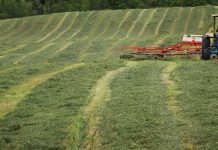By Thomas E. Noyes
Dairy producers have just been through an extended period of record low milk prices. During this period many options may have been considered as a way to reduce costs and improve profitability.
Some have adopted grazing stating that it can reduce feed costs, reduce operating costs for cropping and improve their lifestyle.
Latest reports. We now have some statistics that can verify the profitability of dairies utilizing a managed grazing program.
New York has been collecting data and printing a report of farms using management-intensive grazing for six years. The Great Lakes Grazing Network, with a USDA grant, has collected data from grazing dairies and printed a report for two years.
The latest reports I have for these two studies are from 2001 and I will highlight some of the findings. Results for 2002 will be available soon.
Both reports are very specific as to who practiced a managed grazing system to be included in the study.
Definitions. A grazing dairy is one that grazed dairy cows at least three months, moving to a fresh paddock at least every three days and more than 30 percent of the forage consumed during the growing season was from grazing.
The New York report has 54 farms that fit the definition and supplied usable data. They were compared with 98 farms of similar size that were non-grazing farms.
When you look at the numbers comparing grazing farms vs. non-grazing farms of similar size, the graziers were more profitable.
Although the grazing dairies produced less milk per cow – 16,295 pounds compared to 19,105 pounds – they made up the difference by receiving $16.69 per hundredweight vs. $16.09 per hundredweight and having a lower cost of producing a hundred pounds of milk.
Comparisons. The comparisons in the table show that grazing dairies do have lower feed costs, do have lower machinery and crop costs and do have lower vet and medicine cost which may mean healthier cows.
The grazing dairies have a $59 net income per cow advantage over the non-grazing dairies. However, the top non-grazing dairies had an advantage in net income per cow being $950 vs. $806 for the top-grazing dairy.
Above and below. Just like with conventional farms there is a significant difference in the income and expenses between the above-average and below-average farms.
The net income per cow for the above-average farms was $806 compared to the $79 for the below-average farms.
The above-average graziers had higher production per cow with 16,637 vs. 11,958 for the below-average farms.
Costs for the production of milk were very similar except for feed costs (both produced and purchased) with the above average herds having higher costs simply because the production per cow was so much greater.
Another look. The financial data for the grazing dairies in the Great Lakes Grazing Network summary show similar results.
There were 126 grazing dairy farms that submitted data for the summary. These farms were located in seven states around the great lakes and Ontario Canada.
There is also a major difference between the top grazier and the below-average grazier to be the control of costs.
The basic costs in the table include purchased feed, vet and medicine, breeding, cropping expenses, supplies, etc. minus interest, labor and depreciation.
Again there is significant difference between the top graziers and the bottom graizers.
Profitable. There is enough economic data out there now to say that management-intensive grazing can be a profitable alternative to total confinement dairying.
Most of the herds tend to be smaller and they reduce the inventory of machinery and equipment. They do show reduced costs for cropping and feed costs per cow.
However, as the name implies “management” is the key to success when choosing a grazing system for the dairy farm. It will require a different way of thinking.
(Thomas E. Noyes is the Wayne County Extension dairy agent. Questions or comments can be sent in care of Farm and Dairy, P.O. Box 38, Salem OH 44460.)












